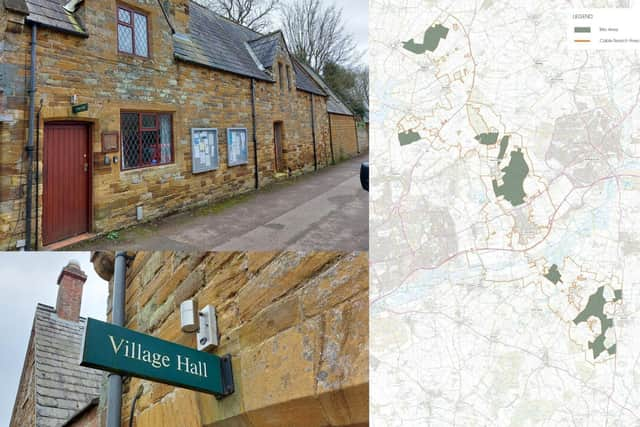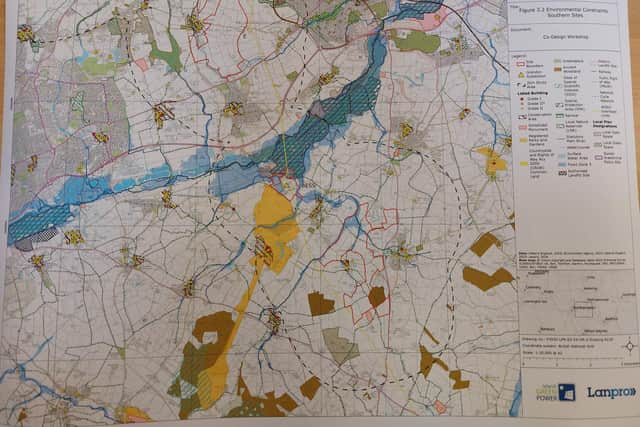Early plans laid out for over 2,000 acres of solar farms in Northamptonshire at consultation event in Mears Ashby
and live on Freeview channel 276
A development that could see around 950 hectares (2,347 acres) taken up by solar panels and renewable power outlets in Northamptonshire has been put to residents, parish councillors and concerned parties at a consultation held at Mears Ashby village hall.
People were invited to yesterday’s (Tuesday) non-statutory consultation as the applicant Green Hill Solar Farm, a subsidiary of Island Green Power, hoped to ‘tap into' local knowledge to help shape the plans before it submits a Development Consent Order (DCO) in February 2025.
Advertisement
Hide AdAdvertisement
Hide AdA spokesman for Island Green Power said: “Our plans are still at an early stage. We have carried out initial studies and assessments to identify areas of land that would potentially be suitable for a proposed solar farm with energy storage and cable route corridor connecting to Grendon substation.


"The energy storage element of the scheme will help store surplus renewable generation and then deploy it to the national grid when it is needed. Green Hill Solar Farm would provide a maximum power output of 500 MW, providing a substantial source of renewable electricity for the region and country.
"We want to use the information provided to help shape the site, we are keen for this to be a collaborative process.”
Seven sites across 10 parishes have been preliminarily mapped out by the developer that span from Bozeat and Easton Maudit to just north of Walgrave, including a substantial portion between Mears Ashby and Earls Barton.
Advertisement
Hide AdAdvertisement
Hide AdWithin a 2km distance of the planned sites there are 318 listed buildings, 10 of which are grade 1 listed, and 15 are grade 2 listed, including the Church of St Mary in Grendon.


The applicant is keen to gather insight about ‘which fields would be suitable or unsuitable’, and intend to use the session to gather local knowledge on elements like access routes, local wildlife, and other key issues that could affect the plans.
A passage from the presentation delivered to those who attended the session reads: “We value your feedback on what you would like to see and what would be of most benefit for communities closest to the project.”
The area that was chosen as the central point of the plans are Grendon’s 400KV substation, with approximately 21km of underground cables connecting the sites, though the exact route for the cables ‘haven’t yet been refined’ as the project is in its early stages of development.
Locals’ Concerns About ‘Enormous’ Project
Advertisement
Hide AdAdvertisement
Hide AdSeven topics consisting of transport, biodiversity, visual impact, water environment and socio-economic considerations were addressed by companies associated with the development including Clarkson and Woods, an ecological consultancy, and Lanpro, which is providing planning support for the project.
However, plenty of queries and concerns were raised by those in attendance relating to food production, biodiversity, house prices and visual impact.
Juliet Jarvis, a Grendon resident and member of the Working Party for Solar Development, called the issue ‘enormous’.
She said: “What you’re planning to do in Grendon will completely transform our fields in every way. You’ll just fundamentally change our homes.
"This will have such a significant impact on our villages.”
Advertisement
Hide AdAdvertisement
Hide AdShe also said that Northamptonshire is taking ‘more than its fair share’ of renewable energy infrastructure.
Chaz Beaumont, a resident of Easton Maudit, said: "I don’t see a benefit at all, just a lot of destruction. I bought my house here in this nice village to retire to, and in five years of living here this appears.”
John Butt, a Sywell resident said: “If you’re going to surround houses with solar panels it’s not going to do much for house prices.
“A lot of people like a nice view and you are going to destroy that.”
Advertisement
Hide AdAdvertisement
Hide AdMichael Curtis, an attendee at the session highlighted the archeological impact of the proposal, saying: “This area really has changed our perception of archeology, there’s so much we still need to learn.”
Juliet Jarvis noted that ‘a lot of the land is agricultural’, which Charles Judson confirmed, believing most of the proposed sites to be Agricultural Land Classification grade 3, which the government website says is ‘good to moderate quality agricultural land’ and ‘land with moderate limitations that affect the choice of crops, timing and type of cultivation, harvesting or the level of yield.’ A survey is to be conducted to confirm the official grading of the site.
What’s Next for the Green Hill Solar Farm?
Should the work go ahead as planned, which Charles Judson of Lanpro notes will take ‘in the region of two years’ to come to fruition, the solar farms will be operational for a 60-year period.
However, the common performance guarantee of the solar panels is around 25 years, meaning they will likely need to be changed at least once before they are decommissioned and the land is returned to its former use.
Advertisement
Hide AdAdvertisement
Hide AdThe next step for the project is to submit an environmental impact assessment to the planning inspectorate, and a preliminary environmental information report will be submitted in the summer before a statutory consultation with affected parties in September and October.
More information about the development can be found here.